Health Advocacy Strategy: Aboriginal Peoples and Vaccination Policy
VerifiedAdded on 2022/11/26
|12
|3241
|389
Report
AI Summary
This report presents a health advocacy strategy developed to address the impact of a policy change regarding the removal of free measles and influenza vaccines on aboriginal communities in Australia. The paper analyzes the health and economic disadvantages faced by this group, emphasizing their increased vulnerability to infectious diseases due to factors like lack of knowledge and limited access to healthcare. It examines the government's policy shift, highlighting the potential for increased disease prevalence and health inequalities. The report provides background information on vaccination, disease transmission, and the significance of vaccination programs. It identifies the aboriginal community as a high-risk group and outlines the potential consequences of the policy change. Furthermore, it proposes alternative policy options, such as door-to-door vaccination services and health education programs, and suggests contributions that NGOs can make to public debate, including documentaries and social media campaigns, to advocate for improved health outcomes for aboriginal peoples. The report emphasizes the importance of advocating for free vaccines and quality healthcare to protect the community.
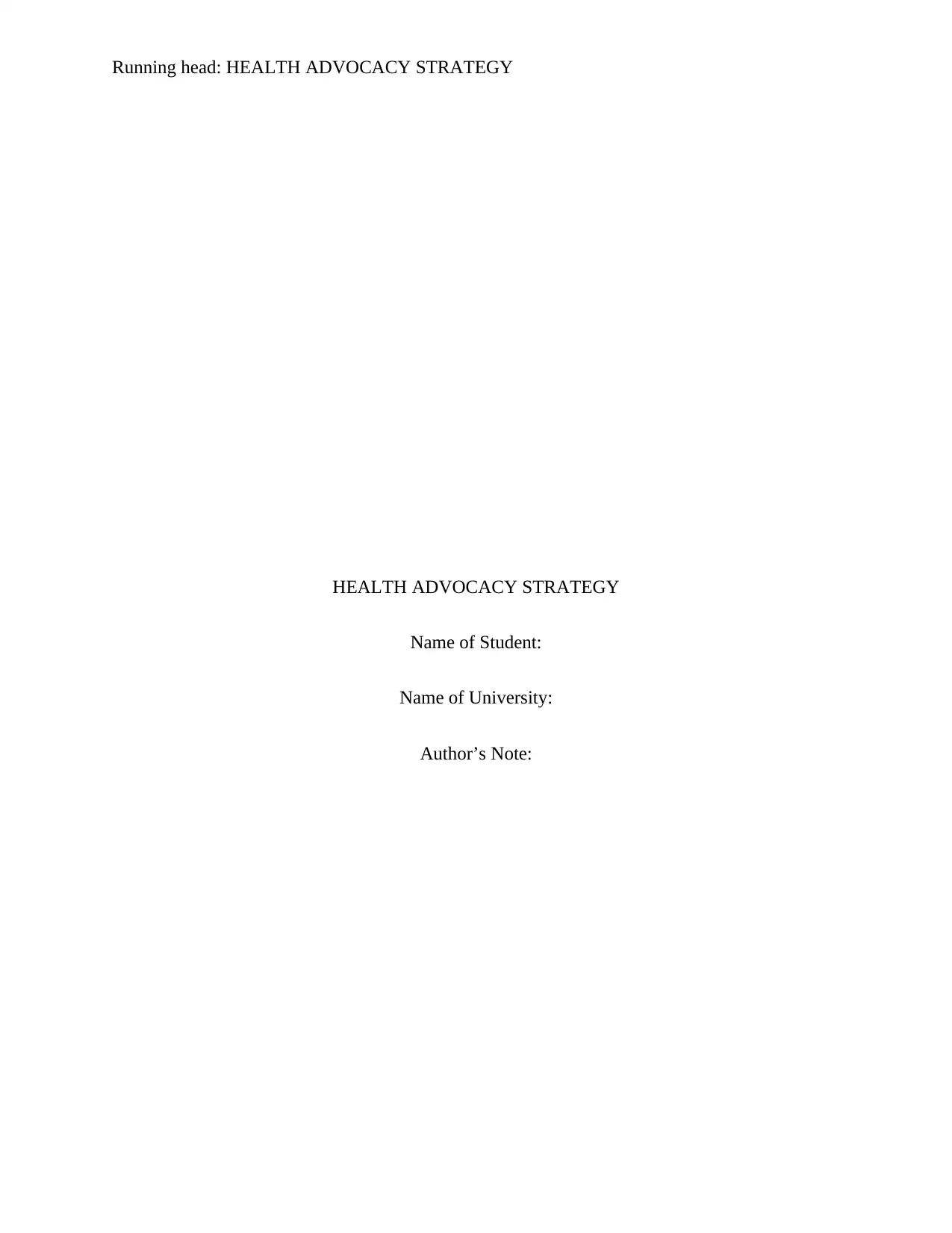
Running head: HEALTH ADVOCACY STRATEGY
HEALTH ADVOCACY STRATEGY
Name of Student:
Name of University:
Author’s Note:
HEALTH ADVOCACY STRATEGY
Name of Student:
Name of University:
Author’s Note:
Paraphrase This Document
Need a fresh take? Get an instant paraphrase of this document with our AI Paraphraser
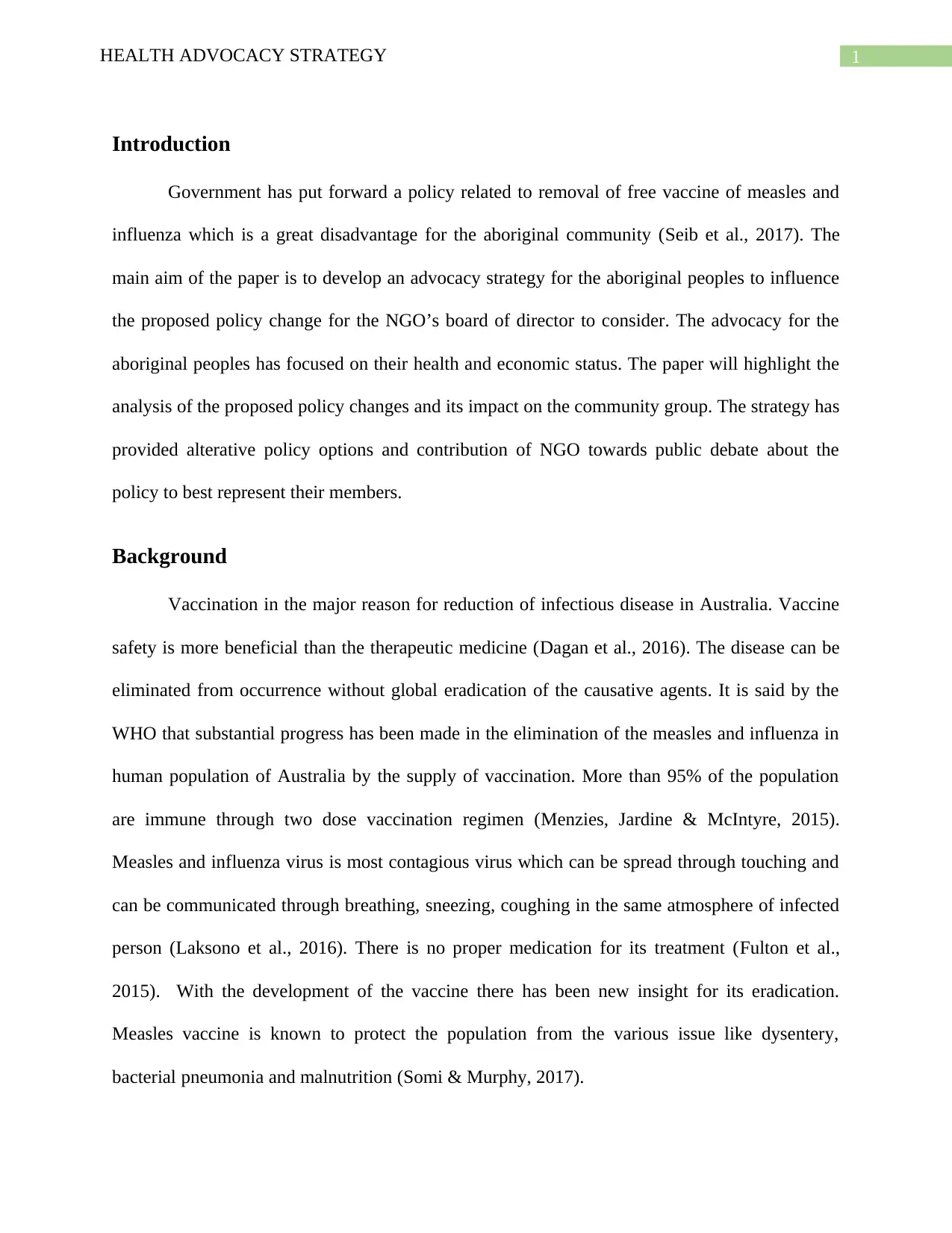
1HEALTH ADVOCACY STRATEGY
Introduction
Government has put forward a policy related to removal of free vaccine of measles and
influenza which is a great disadvantage for the aboriginal community (Seib et al., 2017). The
main aim of the paper is to develop an advocacy strategy for the aboriginal peoples to influence
the proposed policy change for the NGO’s board of director to consider. The advocacy for the
aboriginal peoples has focused on their health and economic status. The paper will highlight the
analysis of the proposed policy changes and its impact on the community group. The strategy has
provided alterative policy options and contribution of NGO towards public debate about the
policy to best represent their members.
Background
Vaccination in the major reason for reduction of infectious disease in Australia. Vaccine
safety is more beneficial than the therapeutic medicine (Dagan et al., 2016). The disease can be
eliminated from occurrence without global eradication of the causative agents. It is said by the
WHO that substantial progress has been made in the elimination of the measles and influenza in
human population of Australia by the supply of vaccination. More than 95% of the population
are immune through two dose vaccination regimen (Menzies, Jardine & McIntyre, 2015).
Measles and influenza virus is most contagious virus which can be spread through touching and
can be communicated through breathing, sneezing, coughing in the same atmosphere of infected
person (Laksono et al., 2016). There is no proper medication for its treatment (Fulton et al.,
2015). With the development of the vaccine there has been new insight for its eradication.
Measles vaccine is known to protect the population from the various issue like dysentery,
bacterial pneumonia and malnutrition (Somi & Murphy, 2017).
Introduction
Government has put forward a policy related to removal of free vaccine of measles and
influenza which is a great disadvantage for the aboriginal community (Seib et al., 2017). The
main aim of the paper is to develop an advocacy strategy for the aboriginal peoples to influence
the proposed policy change for the NGO’s board of director to consider. The advocacy for the
aboriginal peoples has focused on their health and economic status. The paper will highlight the
analysis of the proposed policy changes and its impact on the community group. The strategy has
provided alterative policy options and contribution of NGO towards public debate about the
policy to best represent their members.
Background
Vaccination in the major reason for reduction of infectious disease in Australia. Vaccine
safety is more beneficial than the therapeutic medicine (Dagan et al., 2016). The disease can be
eliminated from occurrence without global eradication of the causative agents. It is said by the
WHO that substantial progress has been made in the elimination of the measles and influenza in
human population of Australia by the supply of vaccination. More than 95% of the population
are immune through two dose vaccination regimen (Menzies, Jardine & McIntyre, 2015).
Measles and influenza virus is most contagious virus which can be spread through touching and
can be communicated through breathing, sneezing, coughing in the same atmosphere of infected
person (Laksono et al., 2016). There is no proper medication for its treatment (Fulton et al.,
2015). With the development of the vaccine there has been new insight for its eradication.
Measles vaccine is known to protect the population from the various issue like dysentery,
bacterial pneumonia and malnutrition (Somi & Murphy, 2017).
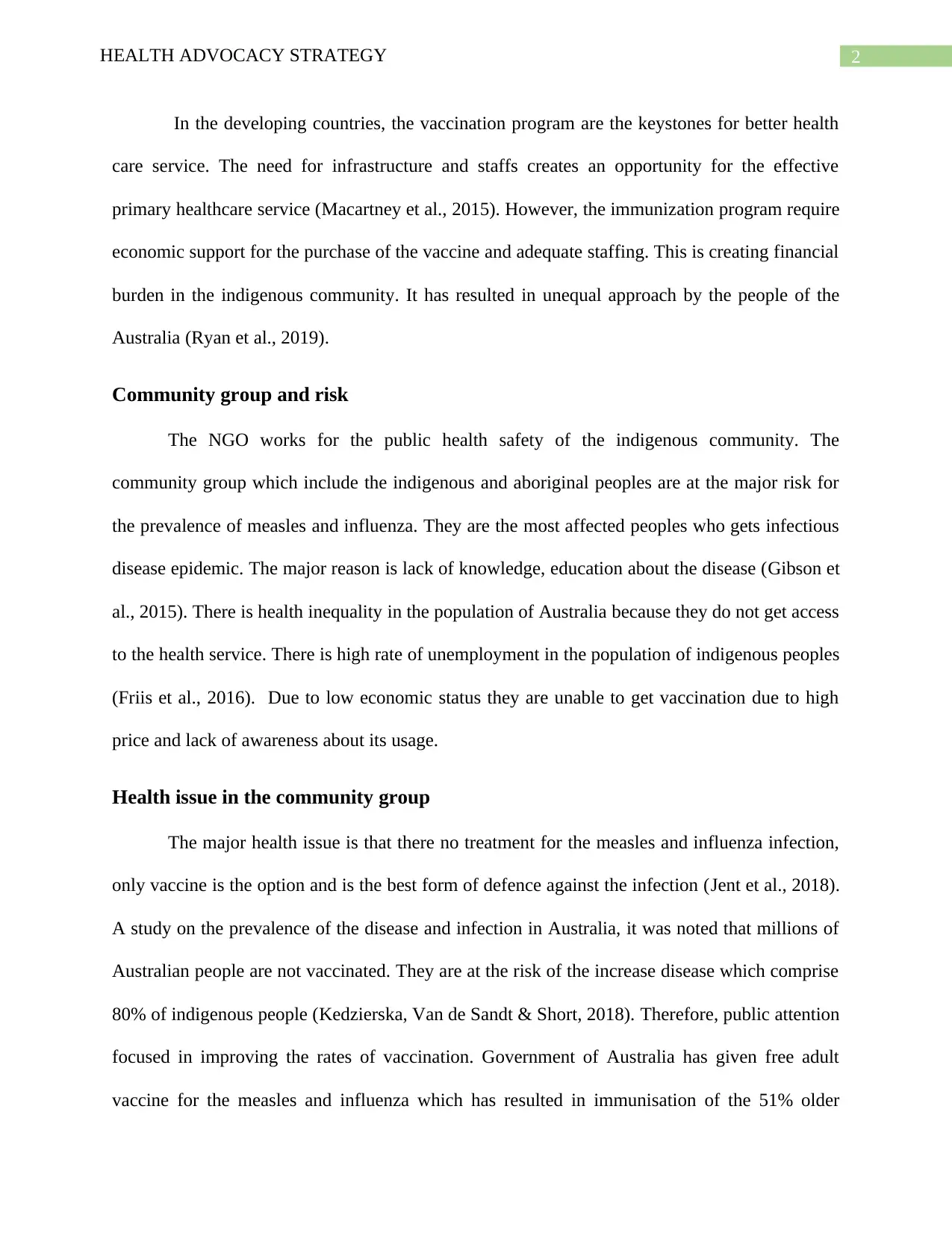
2HEALTH ADVOCACY STRATEGY
In the developing countries, the vaccination program are the keystones for better health
care service. The need for infrastructure and staffs creates an opportunity for the effective
primary healthcare service (Macartney et al., 2015). However, the immunization program require
economic support for the purchase of the vaccine and adequate staffing. This is creating financial
burden in the indigenous community. It has resulted in unequal approach by the people of the
Australia (Ryan et al., 2019).
Community group and risk
The NGO works for the public health safety of the indigenous community. The
community group which include the indigenous and aboriginal peoples are at the major risk for
the prevalence of measles and influenza. They are the most affected peoples who gets infectious
disease epidemic. The major reason is lack of knowledge, education about the disease (Gibson et
al., 2015). There is health inequality in the population of Australia because they do not get access
to the health service. There is high rate of unemployment in the population of indigenous peoples
(Friis et al., 2016). Due to low economic status they are unable to get vaccination due to high
price and lack of awareness about its usage.
Health issue in the community group
The major health issue is that there no treatment for the measles and influenza infection,
only vaccine is the option and is the best form of defence against the infection (Jent et al., 2018).
A study on the prevalence of the disease and infection in Australia, it was noted that millions of
Australian people are not vaccinated. They are at the risk of the increase disease which comprise
80% of indigenous people (Kedzierska, Van de Sandt & Short, 2018). Therefore, public attention
focused in improving the rates of vaccination. Government of Australia has given free adult
vaccine for the measles and influenza which has resulted in immunisation of the 51% older
In the developing countries, the vaccination program are the keystones for better health
care service. The need for infrastructure and staffs creates an opportunity for the effective
primary healthcare service (Macartney et al., 2015). However, the immunization program require
economic support for the purchase of the vaccine and adequate staffing. This is creating financial
burden in the indigenous community. It has resulted in unequal approach by the people of the
Australia (Ryan et al., 2019).
Community group and risk
The NGO works for the public health safety of the indigenous community. The
community group which include the indigenous and aboriginal peoples are at the major risk for
the prevalence of measles and influenza. They are the most affected peoples who gets infectious
disease epidemic. The major reason is lack of knowledge, education about the disease (Gibson et
al., 2015). There is health inequality in the population of Australia because they do not get access
to the health service. There is high rate of unemployment in the population of indigenous peoples
(Friis et al., 2016). Due to low economic status they are unable to get vaccination due to high
price and lack of awareness about its usage.
Health issue in the community group
The major health issue is that there no treatment for the measles and influenza infection,
only vaccine is the option and is the best form of defence against the infection (Jent et al., 2018).
A study on the prevalence of the disease and infection in Australia, it was noted that millions of
Australian people are not vaccinated. They are at the risk of the increase disease which comprise
80% of indigenous people (Kedzierska, Van de Sandt & Short, 2018). Therefore, public attention
focused in improving the rates of vaccination. Government of Australia has given free adult
vaccine for the measles and influenza which has resulted in immunisation of the 51% older
⊘ This is a preview!⊘
Do you want full access?
Subscribe today to unlock all pages.

Trusted by 1+ million students worldwide
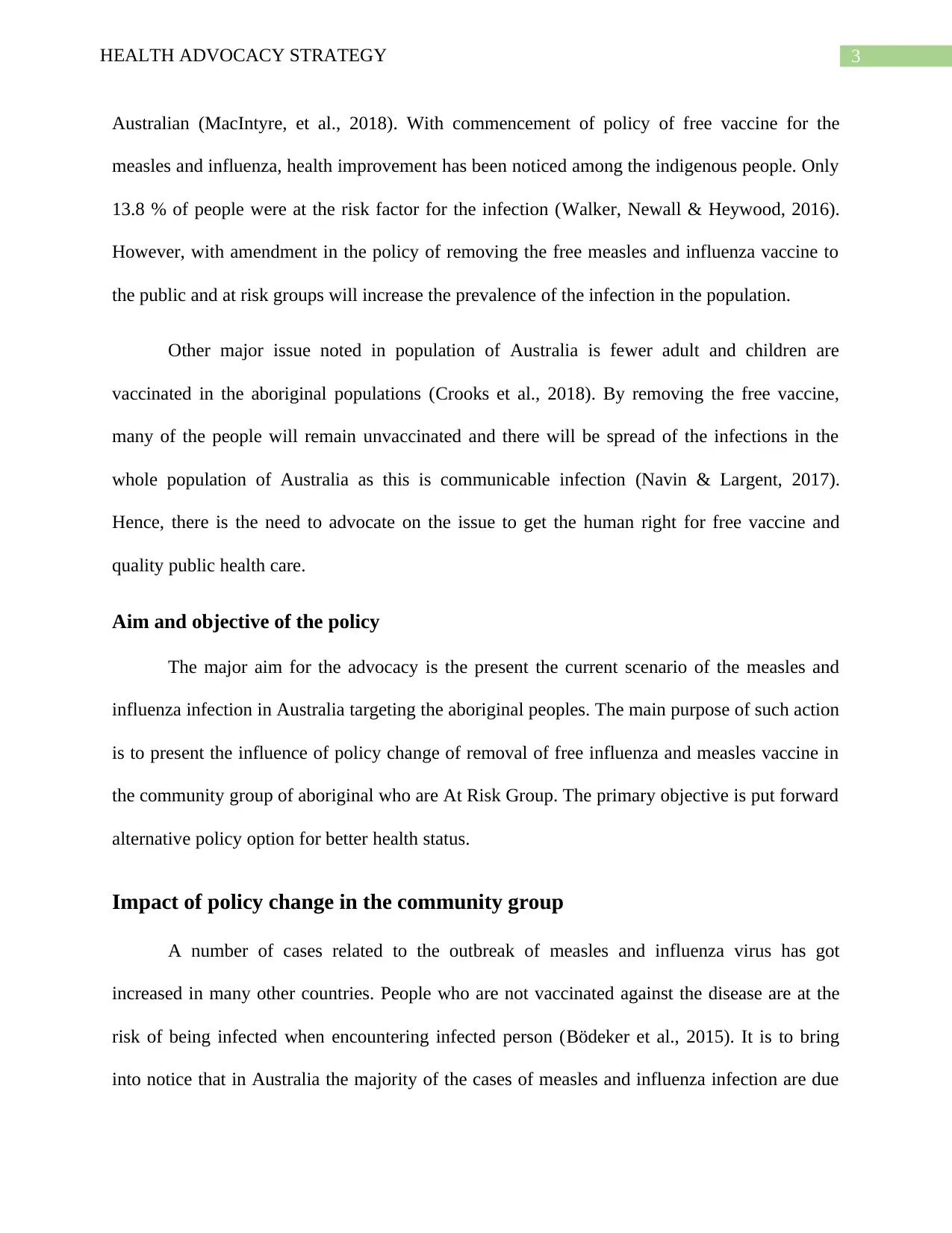
3HEALTH ADVOCACY STRATEGY
Australian (MacIntyre, et al., 2018). With commencement of policy of free vaccine for the
measles and influenza, health improvement has been noticed among the indigenous people. Only
13.8 % of people were at the risk factor for the infection (Walker, Newall & Heywood, 2016).
However, with amendment in the policy of removing the free measles and influenza vaccine to
the public and at risk groups will increase the prevalence of the infection in the population.
Other major issue noted in population of Australia is fewer adult and children are
vaccinated in the aboriginal populations (Crooks et al., 2018). By removing the free vaccine,
many of the people will remain unvaccinated and there will be spread of the infections in the
whole population of Australia as this is communicable infection (Navin & Largent, 2017).
Hence, there is the need to advocate on the issue to get the human right for free vaccine and
quality public health care.
Aim and objective of the policy
The major aim for the advocacy is the present the current scenario of the measles and
influenza infection in Australia targeting the aboriginal peoples. The main purpose of such action
is to present the influence of policy change of removal of free influenza and measles vaccine in
the community group of aboriginal who are At Risk Group. The primary objective is put forward
alternative policy option for better health status.
Impact of policy change in the community group
A number of cases related to the outbreak of measles and influenza virus has got
increased in many other countries. People who are not vaccinated against the disease are at the
risk of being infected when encountering infected person (Bödeker et al., 2015). It is to bring
into notice that in Australia the majority of the cases of measles and influenza infection are due
Australian (MacIntyre, et al., 2018). With commencement of policy of free vaccine for the
measles and influenza, health improvement has been noticed among the indigenous people. Only
13.8 % of people were at the risk factor for the infection (Walker, Newall & Heywood, 2016).
However, with amendment in the policy of removing the free measles and influenza vaccine to
the public and at risk groups will increase the prevalence of the infection in the population.
Other major issue noted in population of Australia is fewer adult and children are
vaccinated in the aboriginal populations (Crooks et al., 2018). By removing the free vaccine,
many of the people will remain unvaccinated and there will be spread of the infections in the
whole population of Australia as this is communicable infection (Navin & Largent, 2017).
Hence, there is the need to advocate on the issue to get the human right for free vaccine and
quality public health care.
Aim and objective of the policy
The major aim for the advocacy is the present the current scenario of the measles and
influenza infection in Australia targeting the aboriginal peoples. The main purpose of such action
is to present the influence of policy change of removal of free influenza and measles vaccine in
the community group of aboriginal who are At Risk Group. The primary objective is put forward
alternative policy option for better health status.
Impact of policy change in the community group
A number of cases related to the outbreak of measles and influenza virus has got
increased in many other countries. People who are not vaccinated against the disease are at the
risk of being infected when encountering infected person (Bödeker et al., 2015). It is to bring
into notice that in Australia the majority of the cases of measles and influenza infection are due
Paraphrase This Document
Need a fresh take? Get an instant paraphrase of this document with our AI Paraphraser
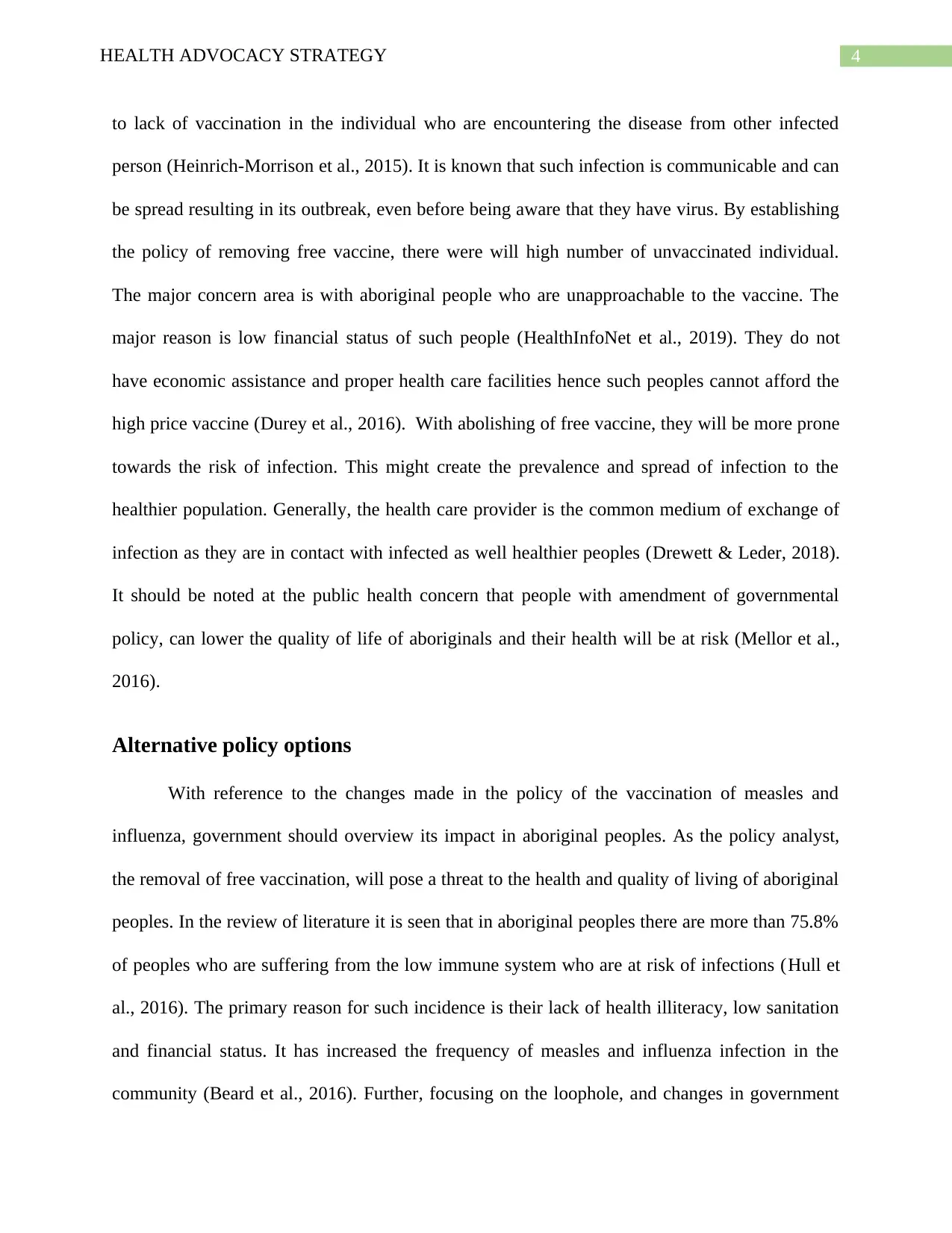
4HEALTH ADVOCACY STRATEGY
to lack of vaccination in the individual who are encountering the disease from other infected
person (Heinrich-Morrison et al., 2015). It is known that such infection is communicable and can
be spread resulting in its outbreak, even before being aware that they have virus. By establishing
the policy of removing free vaccine, there were will high number of unvaccinated individual.
The major concern area is with aboriginal people who are unapproachable to the vaccine. The
major reason is low financial status of such people (HealthInfoNet et al., 2019). They do not
have economic assistance and proper health care facilities hence such peoples cannot afford the
high price vaccine (Durey et al., 2016). With abolishing of free vaccine, they will be more prone
towards the risk of infection. This might create the prevalence and spread of infection to the
healthier population. Generally, the health care provider is the common medium of exchange of
infection as they are in contact with infected as well healthier peoples (Drewett & Leder, 2018).
It should be noted at the public health concern that people with amendment of governmental
policy, can lower the quality of life of aboriginals and their health will be at risk (Mellor et al.,
2016).
Alternative policy options
With reference to the changes made in the policy of the vaccination of measles and
influenza, government should overview its impact in aboriginal peoples. As the policy analyst,
the removal of free vaccination, will pose a threat to the health and quality of living of aboriginal
peoples. In the review of literature it is seen that in aboriginal peoples there are more than 75.8%
of peoples who are suffering from the low immune system who are at risk of infections (Hull et
al., 2016). The primary reason for such incidence is their lack of health illiteracy, low sanitation
and financial status. It has increased the frequency of measles and influenza infection in the
community (Beard et al., 2016). Further, focusing on the loophole, and changes in government
to lack of vaccination in the individual who are encountering the disease from other infected
person (Heinrich-Morrison et al., 2015). It is known that such infection is communicable and can
be spread resulting in its outbreak, even before being aware that they have virus. By establishing
the policy of removing free vaccine, there were will high number of unvaccinated individual.
The major concern area is with aboriginal people who are unapproachable to the vaccine. The
major reason is low financial status of such people (HealthInfoNet et al., 2019). They do not
have economic assistance and proper health care facilities hence such peoples cannot afford the
high price vaccine (Durey et al., 2016). With abolishing of free vaccine, they will be more prone
towards the risk of infection. This might create the prevalence and spread of infection to the
healthier population. Generally, the health care provider is the common medium of exchange of
infection as they are in contact with infected as well healthier peoples (Drewett & Leder, 2018).
It should be noted at the public health concern that people with amendment of governmental
policy, can lower the quality of life of aboriginals and their health will be at risk (Mellor et al.,
2016).
Alternative policy options
With reference to the changes made in the policy of the vaccination of measles and
influenza, government should overview its impact in aboriginal peoples. As the policy analyst,
the removal of free vaccination, will pose a threat to the health and quality of living of aboriginal
peoples. In the review of literature it is seen that in aboriginal peoples there are more than 75.8%
of peoples who are suffering from the low immune system who are at risk of infections (Hull et
al., 2016). The primary reason for such incidence is their lack of health illiteracy, low sanitation
and financial status. It has increased the frequency of measles and influenza infection in the
community (Beard et al., 2016). Further, focusing on the loophole, and changes in government
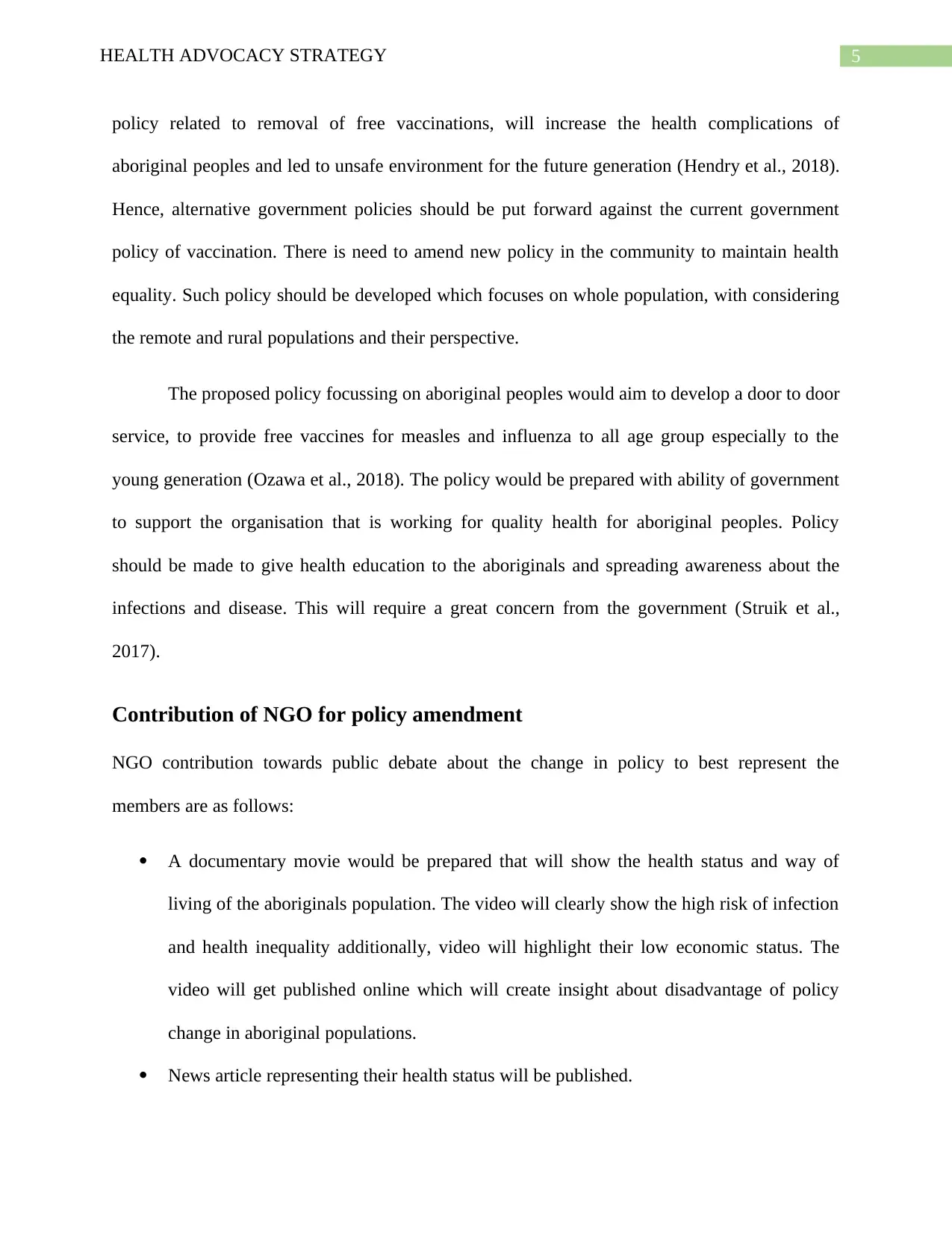
5HEALTH ADVOCACY STRATEGY
policy related to removal of free vaccinations, will increase the health complications of
aboriginal peoples and led to unsafe environment for the future generation (Hendry et al., 2018).
Hence, alternative government policies should be put forward against the current government
policy of vaccination. There is need to amend new policy in the community to maintain health
equality. Such policy should be developed which focuses on whole population, with considering
the remote and rural populations and their perspective.
The proposed policy focussing on aboriginal peoples would aim to develop a door to door
service, to provide free vaccines for measles and influenza to all age group especially to the
young generation (Ozawa et al., 2018). The policy would be prepared with ability of government
to support the organisation that is working for quality health for aboriginal peoples. Policy
should be made to give health education to the aboriginals and spreading awareness about the
infections and disease. This will require a great concern from the government (Struik et al.,
2017).
Contribution of NGO for policy amendment
NGO contribution towards public debate about the change in policy to best represent the
members are as follows:
A documentary movie would be prepared that will show the health status and way of
living of the aboriginals population. The video will clearly show the high risk of infection
and health inequality additionally, video will highlight their low economic status. The
video will get published online which will create insight about disadvantage of policy
change in aboriginal populations.
News article representing their health status will be published.
policy related to removal of free vaccinations, will increase the health complications of
aboriginal peoples and led to unsafe environment for the future generation (Hendry et al., 2018).
Hence, alternative government policies should be put forward against the current government
policy of vaccination. There is need to amend new policy in the community to maintain health
equality. Such policy should be developed which focuses on whole population, with considering
the remote and rural populations and their perspective.
The proposed policy focussing on aboriginal peoples would aim to develop a door to door
service, to provide free vaccines for measles and influenza to all age group especially to the
young generation (Ozawa et al., 2018). The policy would be prepared with ability of government
to support the organisation that is working for quality health for aboriginal peoples. Policy
should be made to give health education to the aboriginals and spreading awareness about the
infections and disease. This will require a great concern from the government (Struik et al.,
2017).
Contribution of NGO for policy amendment
NGO contribution towards public debate about the change in policy to best represent the
members are as follows:
A documentary movie would be prepared that will show the health status and way of
living of the aboriginals population. The video will clearly show the high risk of infection
and health inequality additionally, video will highlight their low economic status. The
video will get published online which will create insight about disadvantage of policy
change in aboriginal populations.
News article representing their health status will be published.
⊘ This is a preview!⊘
Do you want full access?
Subscribe today to unlock all pages.

Trusted by 1+ million students worldwide
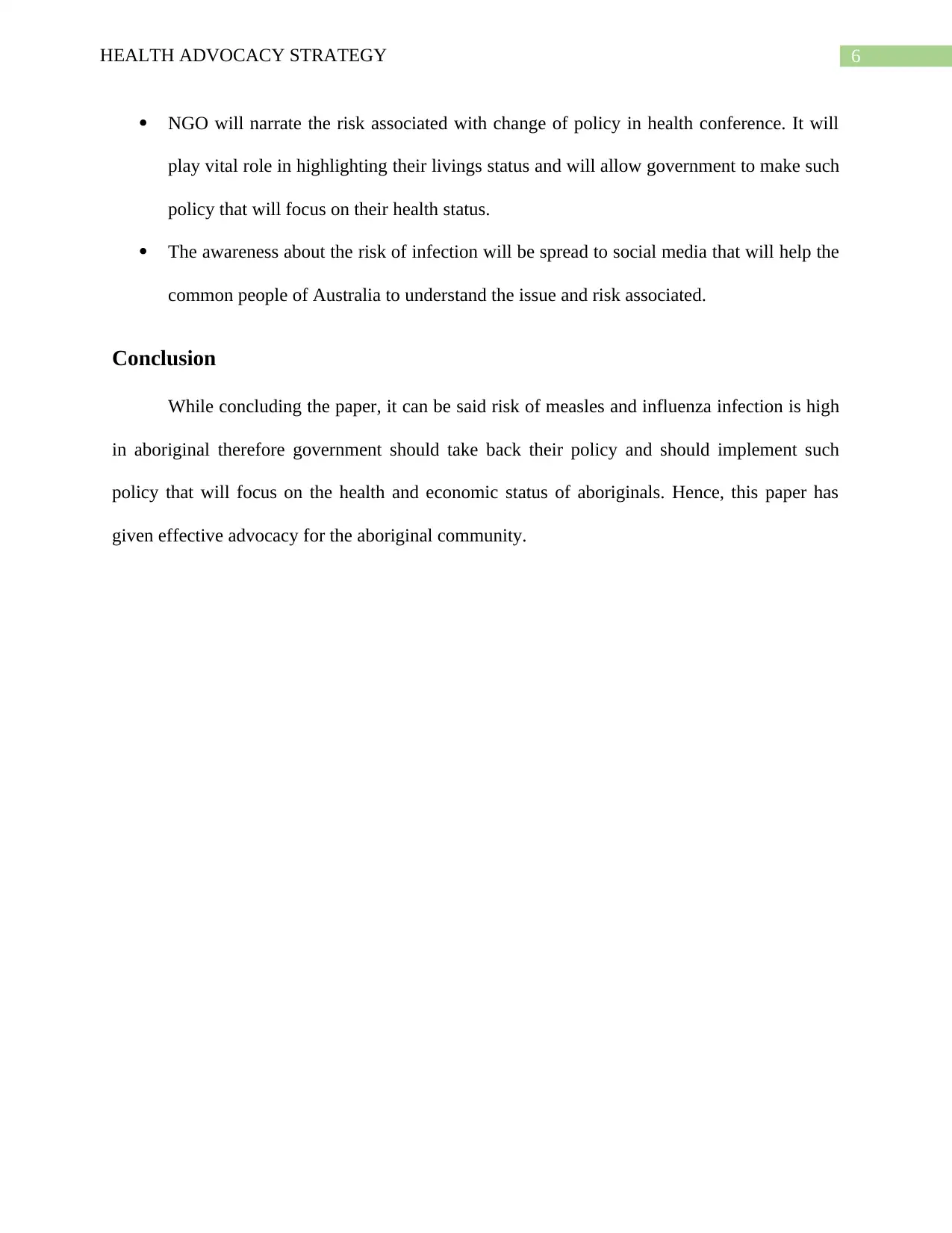
6HEALTH ADVOCACY STRATEGY
NGO will narrate the risk associated with change of policy in health conference. It will
play vital role in highlighting their livings status and will allow government to make such
policy that will focus on their health status.
The awareness about the risk of infection will be spread to social media that will help the
common people of Australia to understand the issue and risk associated.
Conclusion
While concluding the paper, it can be said risk of measles and influenza infection is high
in aboriginal therefore government should take back their policy and should implement such
policy that will focus on the health and economic status of aboriginals. Hence, this paper has
given effective advocacy for the aboriginal community.
NGO will narrate the risk associated with change of policy in health conference. It will
play vital role in highlighting their livings status and will allow government to make such
policy that will focus on their health status.
The awareness about the risk of infection will be spread to social media that will help the
common people of Australia to understand the issue and risk associated.
Conclusion
While concluding the paper, it can be said risk of measles and influenza infection is high
in aboriginal therefore government should take back their policy and should implement such
policy that will focus on the health and economic status of aboriginals. Hence, this paper has
given effective advocacy for the aboriginal community.
Paraphrase This Document
Need a fresh take? Get an instant paraphrase of this document with our AI Paraphraser
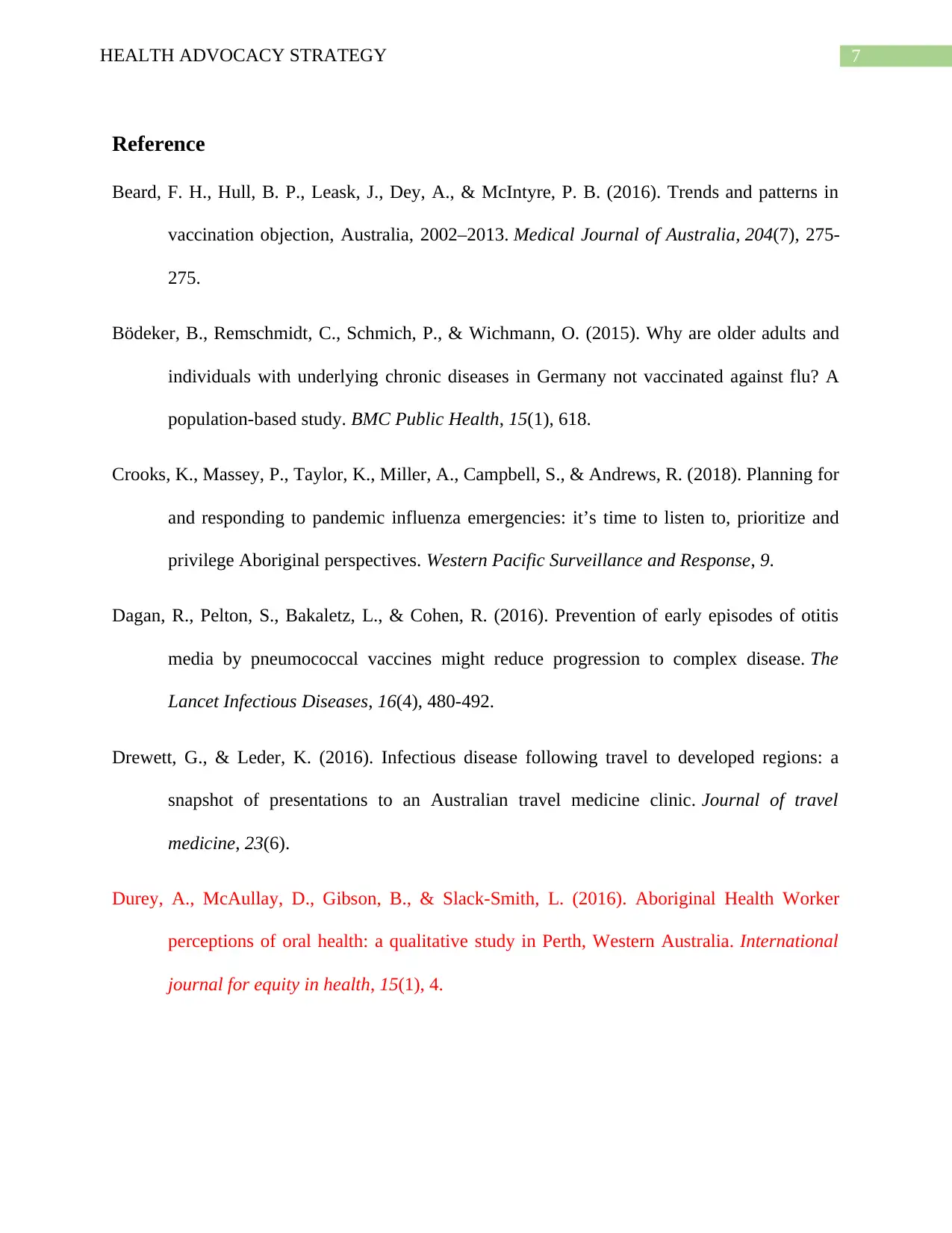
7HEALTH ADVOCACY STRATEGY
Reference
Beard, F. H., Hull, B. P., Leask, J., Dey, A., & McIntyre, P. B. (2016). Trends and patterns in
vaccination objection, Australia, 2002–2013. Medical Journal of Australia, 204(7), 275-
275.
Bödeker, B., Remschmidt, C., Schmich, P., & Wichmann, O. (2015). Why are older adults and
individuals with underlying chronic diseases in Germany not vaccinated against flu? A
population-based study. BMC Public Health, 15(1), 618.
Crooks, K., Massey, P., Taylor, K., Miller, A., Campbell, S., & Andrews, R. (2018). Planning for
and responding to pandemic influenza emergencies: it’s time to listen to, prioritize and
privilege Aboriginal perspectives. Western Pacific Surveillance and Response, 9.
Dagan, R., Pelton, S., Bakaletz, L., & Cohen, R. (2016). Prevention of early episodes of otitis
media by pneumococcal vaccines might reduce progression to complex disease. The
Lancet Infectious Diseases, 16(4), 480-492.
Drewett, G., & Leder, K. (2016). Infectious disease following travel to developed regions: a
snapshot of presentations to an Australian travel medicine clinic. Journal of travel
medicine, 23(6).
Durey, A., McAullay, D., Gibson, B., & Slack-Smith, L. (2016). Aboriginal Health Worker
perceptions of oral health: a qualitative study in Perth, Western Australia. International
journal for equity in health, 15(1), 4.
Reference
Beard, F. H., Hull, B. P., Leask, J., Dey, A., & McIntyre, P. B. (2016). Trends and patterns in
vaccination objection, Australia, 2002–2013. Medical Journal of Australia, 204(7), 275-
275.
Bödeker, B., Remschmidt, C., Schmich, P., & Wichmann, O. (2015). Why are older adults and
individuals with underlying chronic diseases in Germany not vaccinated against flu? A
population-based study. BMC Public Health, 15(1), 618.
Crooks, K., Massey, P., Taylor, K., Miller, A., Campbell, S., & Andrews, R. (2018). Planning for
and responding to pandemic influenza emergencies: it’s time to listen to, prioritize and
privilege Aboriginal perspectives. Western Pacific Surveillance and Response, 9.
Dagan, R., Pelton, S., Bakaletz, L., & Cohen, R. (2016). Prevention of early episodes of otitis
media by pneumococcal vaccines might reduce progression to complex disease. The
Lancet Infectious Diseases, 16(4), 480-492.
Drewett, G., & Leder, K. (2016). Infectious disease following travel to developed regions: a
snapshot of presentations to an Australian travel medicine clinic. Journal of travel
medicine, 23(6).
Durey, A., McAullay, D., Gibson, B., & Slack-Smith, L. (2016). Aboriginal Health Worker
perceptions of oral health: a qualitative study in Perth, Western Australia. International
journal for equity in health, 15(1), 4.
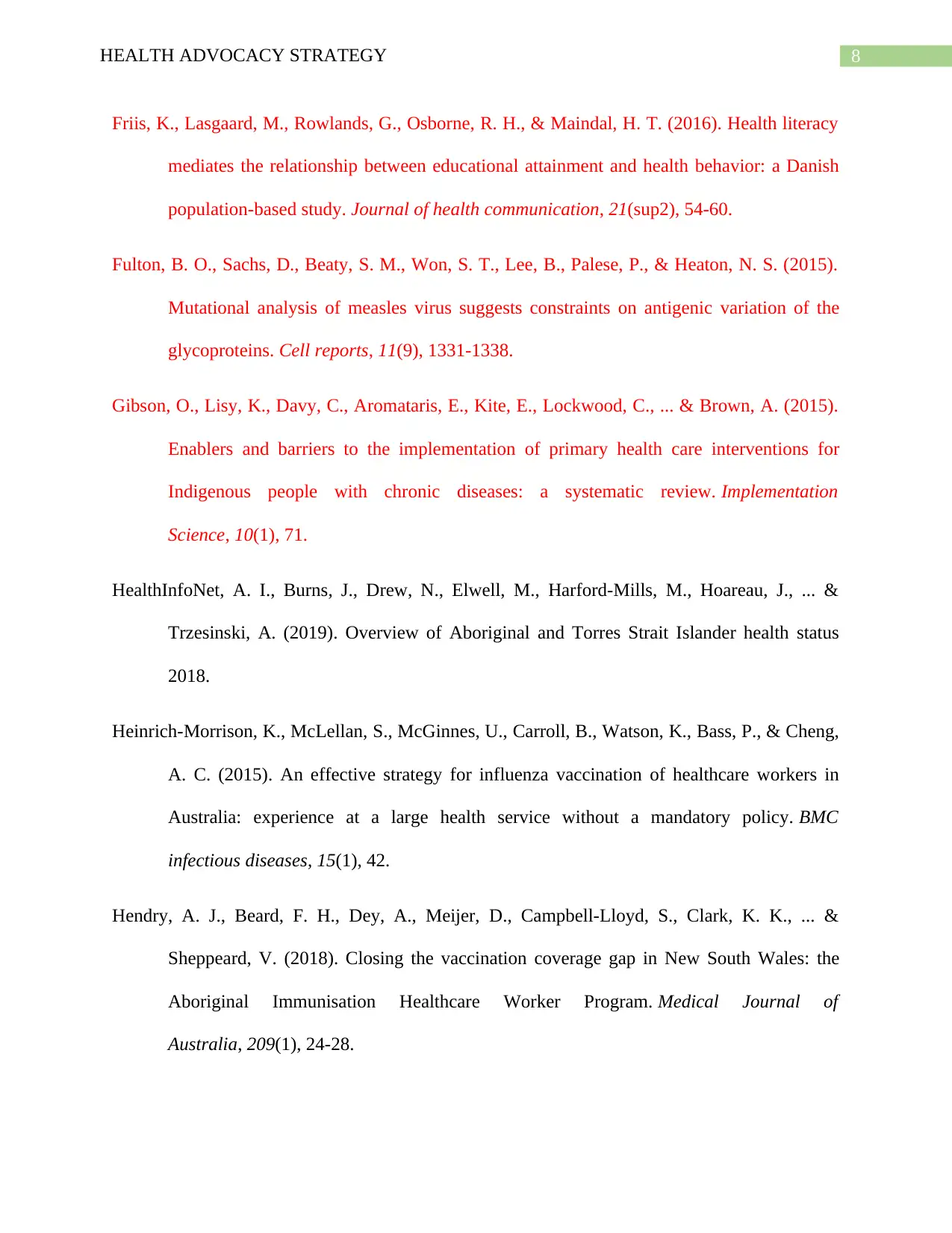
8HEALTH ADVOCACY STRATEGY
Friis, K., Lasgaard, M., Rowlands, G., Osborne, R. H., & Maindal, H. T. (2016). Health literacy
mediates the relationship between educational attainment and health behavior: a Danish
population-based study. Journal of health communication, 21(sup2), 54-60.
Fulton, B. O., Sachs, D., Beaty, S. M., Won, S. T., Lee, B., Palese, P., & Heaton, N. S. (2015).
Mutational analysis of measles virus suggests constraints on antigenic variation of the
glycoproteins. Cell reports, 11(9), 1331-1338.
Gibson, O., Lisy, K., Davy, C., Aromataris, E., Kite, E., Lockwood, C., ... & Brown, A. (2015).
Enablers and barriers to the implementation of primary health care interventions for
Indigenous people with chronic diseases: a systematic review. Implementation
Science, 10(1), 71.
HealthInfoNet, A. I., Burns, J., Drew, N., Elwell, M., Harford-Mills, M., Hoareau, J., ... &
Trzesinski, A. (2019). Overview of Aboriginal and Torres Strait Islander health status
2018.
Heinrich-Morrison, K., McLellan, S., McGinnes, U., Carroll, B., Watson, K., Bass, P., & Cheng,
A. C. (2015). An effective strategy for influenza vaccination of healthcare workers in
Australia: experience at a large health service without a mandatory policy. BMC
infectious diseases, 15(1), 42.
Hendry, A. J., Beard, F. H., Dey, A., Meijer, D., Campbell‐Lloyd, S., Clark, K. K., ... &
Sheppeard, V. (2018). Closing the vaccination coverage gap in New South Wales: the
Aboriginal Immunisation Healthcare Worker Program. Medical Journal of
Australia, 209(1), 24-28.
Friis, K., Lasgaard, M., Rowlands, G., Osborne, R. H., & Maindal, H. T. (2016). Health literacy
mediates the relationship between educational attainment and health behavior: a Danish
population-based study. Journal of health communication, 21(sup2), 54-60.
Fulton, B. O., Sachs, D., Beaty, S. M., Won, S. T., Lee, B., Palese, P., & Heaton, N. S. (2015).
Mutational analysis of measles virus suggests constraints on antigenic variation of the
glycoproteins. Cell reports, 11(9), 1331-1338.
Gibson, O., Lisy, K., Davy, C., Aromataris, E., Kite, E., Lockwood, C., ... & Brown, A. (2015).
Enablers and barriers to the implementation of primary health care interventions for
Indigenous people with chronic diseases: a systematic review. Implementation
Science, 10(1), 71.
HealthInfoNet, A. I., Burns, J., Drew, N., Elwell, M., Harford-Mills, M., Hoareau, J., ... &
Trzesinski, A. (2019). Overview of Aboriginal and Torres Strait Islander health status
2018.
Heinrich-Morrison, K., McLellan, S., McGinnes, U., Carroll, B., Watson, K., Bass, P., & Cheng,
A. C. (2015). An effective strategy for influenza vaccination of healthcare workers in
Australia: experience at a large health service without a mandatory policy. BMC
infectious diseases, 15(1), 42.
Hendry, A. J., Beard, F. H., Dey, A., Meijer, D., Campbell‐Lloyd, S., Clark, K. K., ... &
Sheppeard, V. (2018). Closing the vaccination coverage gap in New South Wales: the
Aboriginal Immunisation Healthcare Worker Program. Medical Journal of
Australia, 209(1), 24-28.
⊘ This is a preview!⊘
Do you want full access?
Subscribe today to unlock all pages.

Trusted by 1+ million students worldwide
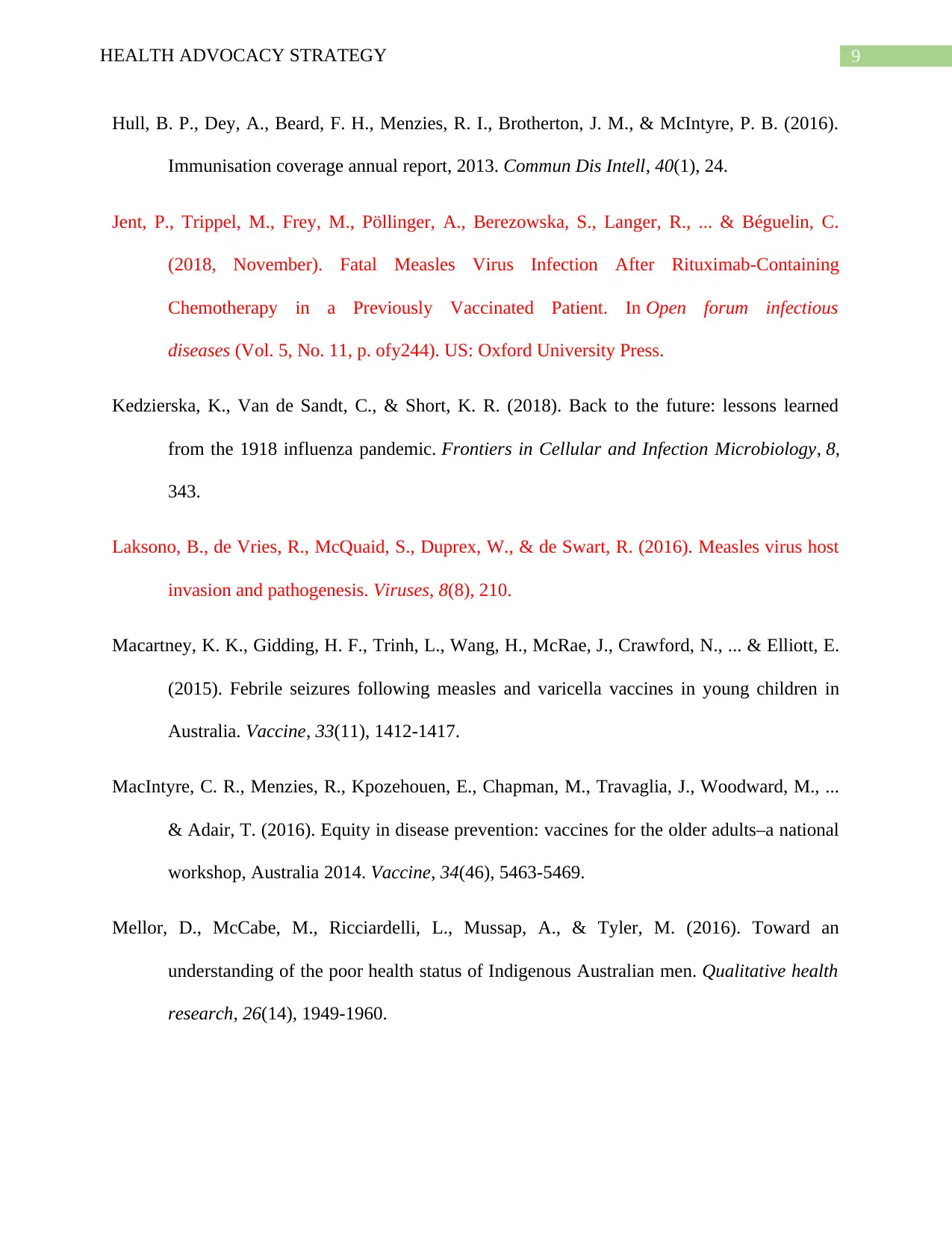
9HEALTH ADVOCACY STRATEGY
Hull, B. P., Dey, A., Beard, F. H., Menzies, R. I., Brotherton, J. M., & McIntyre, P. B. (2016).
Immunisation coverage annual report, 2013. Commun Dis Intell, 40(1), 24.
Jent, P., Trippel, M., Frey, M., Pöllinger, A., Berezowska, S., Langer, R., ... & Béguelin, C.
(2018, November). Fatal Measles Virus Infection After Rituximab-Containing
Chemotherapy in a Previously Vaccinated Patient. In Open forum infectious
diseases (Vol. 5, No. 11, p. ofy244). US: Oxford University Press.
Kedzierska, K., Van de Sandt, C., & Short, K. R. (2018). Back to the future: lessons learned
from the 1918 influenza pandemic. Frontiers in Cellular and Infection Microbiology, 8,
343.
Laksono, B., de Vries, R., McQuaid, S., Duprex, W., & de Swart, R. (2016). Measles virus host
invasion and pathogenesis. Viruses, 8(8), 210.
Macartney, K. K., Gidding, H. F., Trinh, L., Wang, H., McRae, J., Crawford, N., ... & Elliott, E.
(2015). Febrile seizures following measles and varicella vaccines in young children in
Australia. Vaccine, 33(11), 1412-1417.
MacIntyre, C. R., Menzies, R., Kpozehouen, E., Chapman, M., Travaglia, J., Woodward, M., ...
& Adair, T. (2016). Equity in disease prevention: vaccines for the older adults–a national
workshop, Australia 2014. Vaccine, 34(46), 5463-5469.
Mellor, D., McCabe, M., Ricciardelli, L., Mussap, A., & Tyler, M. (2016). Toward an
understanding of the poor health status of Indigenous Australian men. Qualitative health
research, 26(14), 1949-1960.
Hull, B. P., Dey, A., Beard, F. H., Menzies, R. I., Brotherton, J. M., & McIntyre, P. B. (2016).
Immunisation coverage annual report, 2013. Commun Dis Intell, 40(1), 24.
Jent, P., Trippel, M., Frey, M., Pöllinger, A., Berezowska, S., Langer, R., ... & Béguelin, C.
(2018, November). Fatal Measles Virus Infection After Rituximab-Containing
Chemotherapy in a Previously Vaccinated Patient. In Open forum infectious
diseases (Vol. 5, No. 11, p. ofy244). US: Oxford University Press.
Kedzierska, K., Van de Sandt, C., & Short, K. R. (2018). Back to the future: lessons learned
from the 1918 influenza pandemic. Frontiers in Cellular and Infection Microbiology, 8,
343.
Laksono, B., de Vries, R., McQuaid, S., Duprex, W., & de Swart, R. (2016). Measles virus host
invasion and pathogenesis. Viruses, 8(8), 210.
Macartney, K. K., Gidding, H. F., Trinh, L., Wang, H., McRae, J., Crawford, N., ... & Elliott, E.
(2015). Febrile seizures following measles and varicella vaccines in young children in
Australia. Vaccine, 33(11), 1412-1417.
MacIntyre, C. R., Menzies, R., Kpozehouen, E., Chapman, M., Travaglia, J., Woodward, M., ...
& Adair, T. (2016). Equity in disease prevention: vaccines for the older adults–a national
workshop, Australia 2014. Vaccine, 34(46), 5463-5469.
Mellor, D., McCabe, M., Ricciardelli, L., Mussap, A., & Tyler, M. (2016). Toward an
understanding of the poor health status of Indigenous Australian men. Qualitative health
research, 26(14), 1949-1960.
Paraphrase This Document
Need a fresh take? Get an instant paraphrase of this document with our AI Paraphraser
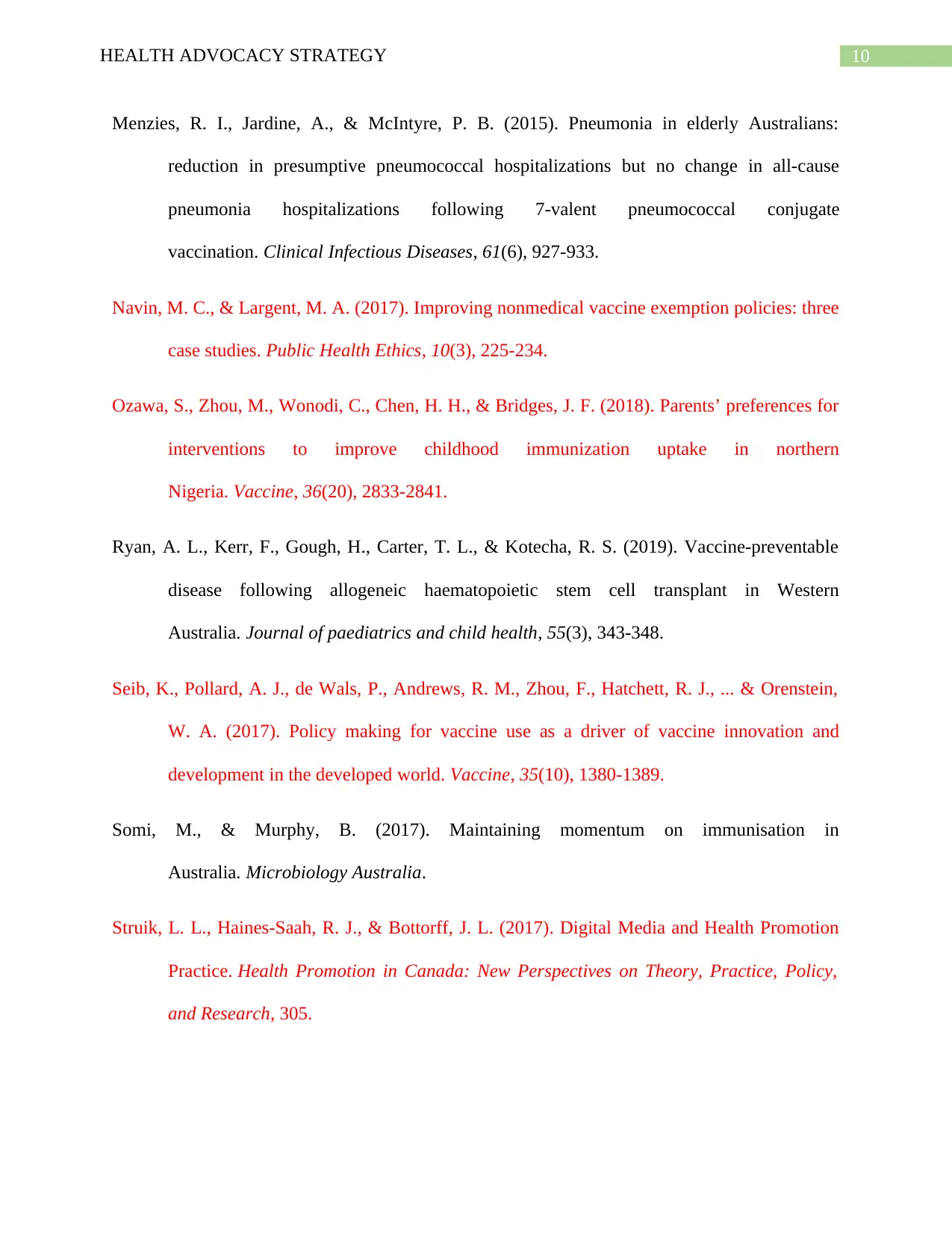
10HEALTH ADVOCACY STRATEGY
Menzies, R. I., Jardine, A., & McIntyre, P. B. (2015). Pneumonia in elderly Australians:
reduction in presumptive pneumococcal hospitalizations but no change in all-cause
pneumonia hospitalizations following 7-valent pneumococcal conjugate
vaccination. Clinical Infectious Diseases, 61(6), 927-933.
Navin, M. C., & Largent, M. A. (2017). Improving nonmedical vaccine exemption policies: three
case studies. Public Health Ethics, 10(3), 225-234.
Ozawa, S., Zhou, M., Wonodi, C., Chen, H. H., & Bridges, J. F. (2018). Parents’ preferences for
interventions to improve childhood immunization uptake in northern
Nigeria. Vaccine, 36(20), 2833-2841.
Ryan, A. L., Kerr, F., Gough, H., Carter, T. L., & Kotecha, R. S. (2019). Vaccine‐preventable
disease following allogeneic haematopoietic stem cell transplant in Western
Australia. Journal of paediatrics and child health, 55(3), 343-348.
Seib, K., Pollard, A. J., de Wals, P., Andrews, R. M., Zhou, F., Hatchett, R. J., ... & Orenstein,
W. A. (2017). Policy making for vaccine use as a driver of vaccine innovation and
development in the developed world. Vaccine, 35(10), 1380-1389.
Somi, M., & Murphy, B. (2017). Maintaining momentum on immunisation in
Australia. Microbiology Australia.
Struik, L. L., Haines-Saah, R. J., & Bottorff, J. L. (2017). Digital Media and Health Promotion
Practice. Health Promotion in Canada: New Perspectives on Theory, Practice, Policy,
and Research, 305.
Menzies, R. I., Jardine, A., & McIntyre, P. B. (2015). Pneumonia in elderly Australians:
reduction in presumptive pneumococcal hospitalizations but no change in all-cause
pneumonia hospitalizations following 7-valent pneumococcal conjugate
vaccination. Clinical Infectious Diseases, 61(6), 927-933.
Navin, M. C., & Largent, M. A. (2017). Improving nonmedical vaccine exemption policies: three
case studies. Public Health Ethics, 10(3), 225-234.
Ozawa, S., Zhou, M., Wonodi, C., Chen, H. H., & Bridges, J. F. (2018). Parents’ preferences for
interventions to improve childhood immunization uptake in northern
Nigeria. Vaccine, 36(20), 2833-2841.
Ryan, A. L., Kerr, F., Gough, H., Carter, T. L., & Kotecha, R. S. (2019). Vaccine‐preventable
disease following allogeneic haematopoietic stem cell transplant in Western
Australia. Journal of paediatrics and child health, 55(3), 343-348.
Seib, K., Pollard, A. J., de Wals, P., Andrews, R. M., Zhou, F., Hatchett, R. J., ... & Orenstein,
W. A. (2017). Policy making for vaccine use as a driver of vaccine innovation and
development in the developed world. Vaccine, 35(10), 1380-1389.
Somi, M., & Murphy, B. (2017). Maintaining momentum on immunisation in
Australia. Microbiology Australia.
Struik, L. L., Haines-Saah, R. J., & Bottorff, J. L. (2017). Digital Media and Health Promotion
Practice. Health Promotion in Canada: New Perspectives on Theory, Practice, Policy,
and Research, 305.
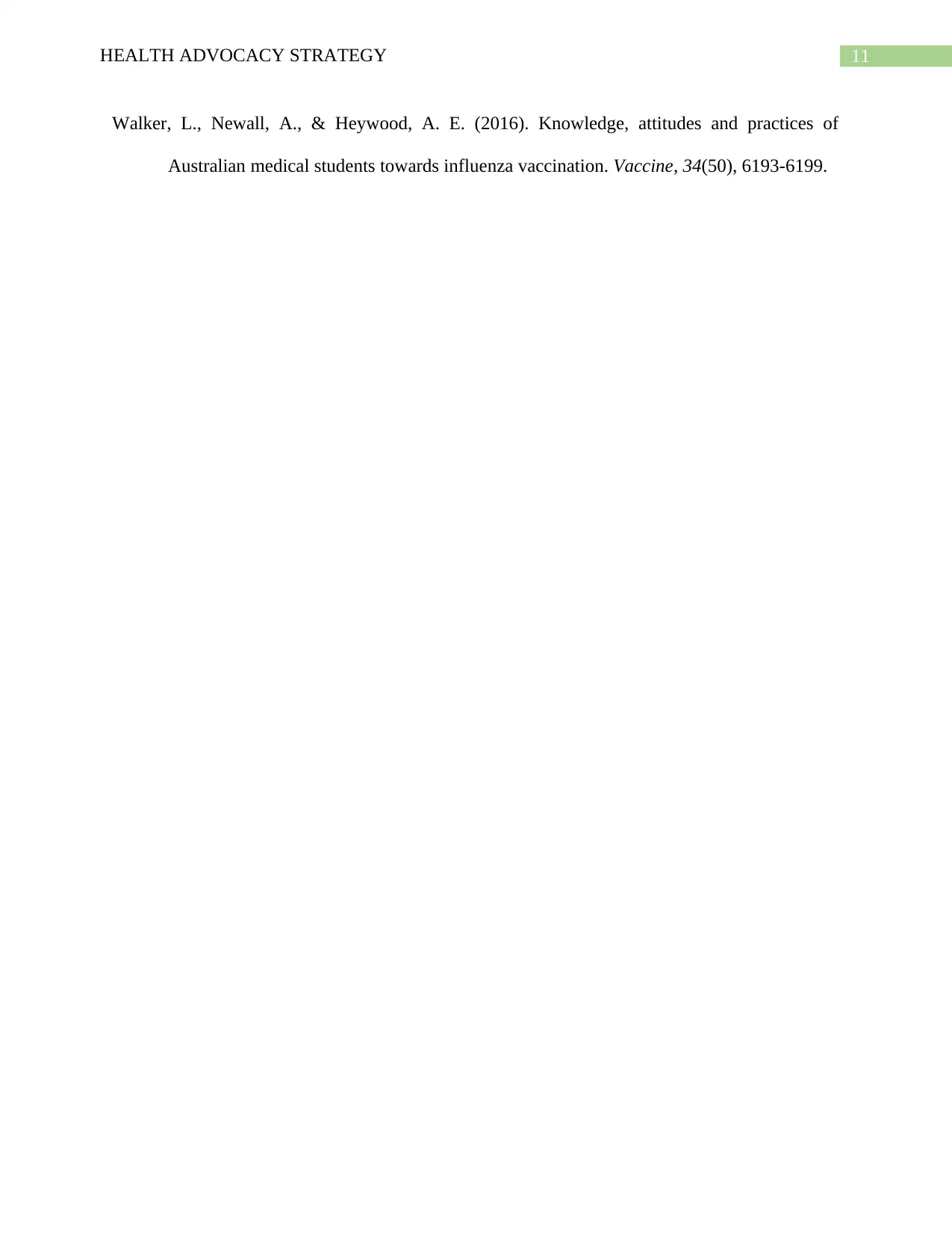
11HEALTH ADVOCACY STRATEGY
Walker, L., Newall, A., & Heywood, A. E. (2016). Knowledge, attitudes and practices of
Australian medical students towards influenza vaccination. Vaccine, 34(50), 6193-6199.
Walker, L., Newall, A., & Heywood, A. E. (2016). Knowledge, attitudes and practices of
Australian medical students towards influenza vaccination. Vaccine, 34(50), 6193-6199.
⊘ This is a preview!⊘
Do you want full access?
Subscribe today to unlock all pages.

Trusted by 1+ million students worldwide
1 out of 12
Related Documents
Your All-in-One AI-Powered Toolkit for Academic Success.
+13062052269
info@desklib.com
Available 24*7 on WhatsApp / Email
![[object Object]](/_next/static/media/star-bottom.7253800d.svg)
Unlock your academic potential
Copyright © 2020–2025 A2Z Services. All Rights Reserved. Developed and managed by ZUCOL.





